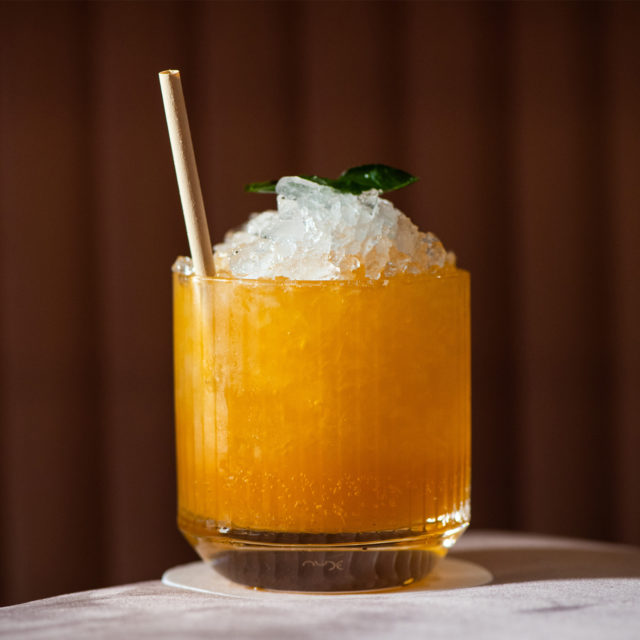Until not too long ago, the only savory cocktail one could bet on at a restaurant was the Bloody Mary. The ubiquitous brunch drink was so lonely in its flavor party for a while that bartenders worldwide started literally piling all their savory hopes and dreams on it, creating Bloodies with edible garnishes reaching ridiculous heights, from a tater tot skewer to a whole fried chicken.
Despite the devastating effects of the pandemic, intriguing and creative savory cocktails are slowly emerging in bars across the country from Los Angeles to Portland, Maine. While some stem from the Bloody Mary, others innovate with nary a tomato or celery stalk, instead opting for savory seaweed or South Indian spices.
“In some way, all the savory cocktails are inspired by the Bloody Mary; when it was invented, that was pretty much the first time someone decided that to put food in a drink was OK,” says mixologist Matthew Biancaniello. Based in L.A., Biancaniello is the former cocktail chef for the now-closed Hollywood Roosevelt Hotel’s Library Bar and the man behind Eat Your Drink, a website that includes a recipe book, cocktail-related content, and resources for at-home mixologists.
At his pre-Covid pop-up at the Los Angeles restaurant N10, Biancaniello served guests The Roquette, a gin Gimlet with wild arugula. The drink also appears on the menu of Nurture, a recently opened cafe and wellness center in Denver that currently offers indoor and outdoor seating in accordance with elaborate restrictions and guidelines. Another savory stunner from N10 included a black truffle mezcal Old Fashioned served in a sea urchin.
Biancaniello says he’s always been in love with the savory mixed drink, but has seen a gradual shift in recent years to imbibers becoming adventurous. “People’s palates have changed and grown,” he says. “As consumers, we all started with classic cocktails, but people are curious about new ingredients. If someone tells me they don’t like a food, they might actually love it in a drink, if the texture goes away.”
Biancaniello’s favorite savory flavors come from the garden or from the sea, and he’s been known to infuse gin with lobster and oysters, for example. These are not the only marine influences inspiring drinks now. Seaweed has become such a popular cocktail ingredient that Josh Rogers, founder of the Heritage Seaweed store in Portland, Maine, recently launched a cocktail garnish in the form of kombu strips, which give a simple mixed drink an umami boost.
At the inaugural Seaweed Week — which Rogers launched in Portland in 2019 — bartenders from Maine establishments, including Vena’s Fizz House and Frontier, created intricate cocktails with the ingredient, and later put them on the menus at their establishments. “I always gravitate towards savory,” Rogers says. “Kombu gives vodka or gin a wonderful oceanic kick and smell.”
Others take cues from the Bloody Mary’s original ingredients. At Viridian, a cocktail bar in Oakland, Calif., the Tomato Beef, a drink with tomato, tequila, and basil eau de vie, is a clearer, stronger answer to the everyday Bloody. Due to Covid restrictions, the cocktail is available to-go.
At Rooh, an Indian restaurant and bar in Palo Alto currently offering outdoor dining, the Whistle Podu is a Bloody Mary riff that substitutes tomato juice with smoked rasam, the spicy South Indian soup based on tamarind and spiced with cumin. Other savory options include a whiskey cocktail with chorizo butter, and a gin cocktail with green chickpeas and cucumber.
Rooh’s head mixologist, Chetan Gangan, says that savory cocktails are being picked up by those who seek novelty or something interesting or unexpected. “Since most guests are more familiar with sweet, sour, or straight-up cocktails, the savory options aren’t as well known,” Rooh says. “As a bartender, learning to balance a savory drink is a more difficult task and deserving of attention.”
Back in L.A.’s Filipinotown, two-year-old Genever (reopening soon for cocktail pickup) offers the Inporridgible, an improbable cocktail containing Bols genever, rice milk, chicken stock, spiced Filipino vinegar, and black pepper. The topping? Fried chicken skin. “It is rich, salty, has spice from fresh ginger and black pepper, and [is] truly reminiscent of arroz caldo,” says Jessie Smyth, bar manager, referring to the traditional Filipino chicken rice porridge. “People love it!”
Another cocktail at Genever, the Filipino G&T, is inspired by chicken adobo. It contains soy sauce, rice wine vinegar, calamansi juice, black pepper, and bay leaf. At first, Smyth says, clients are surprised by its contents. “I’ve been given some crazy looks when describing it,” she says. Then, “once you take a sip — bam!” Smyth says. Bam indeed.
Are savory drinks here to stay, then? “We are seeing a general shift in palates where people are leaning away from sweet drinks and towards the more savory, whether those savory drinks are using salts, vinegars, or spices that were traditionally reserved for the kitchen,” Smyth says. “There is this blurring of the line between kitchen and bar. It does seem trending, and I personally hope it continues.”
